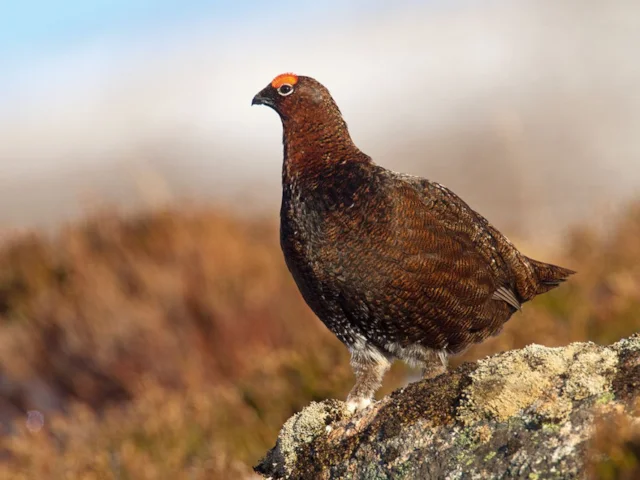August target bird: Red Grouse
04dffa52-cdc8-4278-8027-37ff8c0a2fd6

The spectacular sound of summer on an upland heather moor is the call of Red Grouse and the whirring of wings as one flies away. Red Grouse is a gamebird which can be shot outside the close season. Shooting starts each year on 12 August – known as the ‘Glorious Twelfth’ by the shooting fraternity – unless this falls on a Sunday, and it continues until 10 December.
Red Grouse Lagopus lagopus scoticus is found only in Britain and Ireland, and is at present regarded by most as a subspecies of Willow Grouse, which is found elsewhere in Europe, Asia and North America. It differs from the continental European and North American species in that it does not have white wings, only having white on its legs, doesn’t have a white winter plumage and is confined to upland heather moorland, unlike the other Eurasian and North American birds which inhabit tundra. The Irish Red Grouse has sometimes been regarded as a separate subspecies, L l hibernica, but recent DNA work suggests that it does not warrant subspecific status.
There are an estimated 155,000 pairs in Britain, with most in Scotland, northern England and Wales. Numbers have declined over the last 100 years, as habitat has been lost, and it’s hard to believe that in 1910 a shocking 1,892 birds were shot in a single day on one moor in Scotland. There is a small population on Dartmoor that was originally introduced in 1915. In Ireland there are about 4,200 pairs, with 200 in Northern Ireland.
Numbers fluctuate in a four- or five-year cycle, which may be linked to nematode worm parasites. The large fleshy wattle of red skin above the eye of the male is called a comb. The red skin reflects both in the red and ultraviolet spectrum and seems to be a signal of fitness to the females, meaning that the largest and brightest combs belong to successful males which do not have many parasites. The same also applies to the small combs of females.
The grouse family is unusual among gamebirds in that none of its members are bred in captivity and released, like pheasants and partridges, for subsequent shooting. All Red Grouse are wild and it is the job of the gamekeepers on grouse moors to ensure that their number remain high. This is where there is often conflict, as the RSPB is sure that there are still many moors where the illegal persecution of birds of prey prevails.
The generic name Lagopus means ‘hare foot’ and refers to it having feathered legs, right down to the toes, which is an adaptation that helps the birds to conserve heat in winter. Its legs also have no spurs.
How to see
As Red Grouse are sedentary they can usually be seen at any time of year, and early August is often productive, as there will be plenty of young birds before the shooting season starts. When looking for Red Grouse it is essential to have a good vantage point over an expanse of heather moorland where grouse are known to be present. While the birds can hide if threatened, they will often perch out on a rock, where they are quite obvious. Keep scanning for signs, and also listen for their clear ‘go-back’ call. If you are walking across a moor, always keep to paths – not just for your own safety, but to avoid disturbing wildlife.
Where to Watch
Upland moorland is the only habitat where you will find Red Grouse, especially areas like the North York Moors, Pennines, Lake District, Snowdonia, Brecon Beacons and large areas of Scotland, including the Outer Hebrides, Orkney and Shetland. The sites below are just a few where grouse can be found.
England
• Cumbria: Geltsdale RSPB (NY 588584) and Upper Teesdale NNR (NY 719464)
• North Yorkshire: Scaling Dam (NZ 740125), Arkengarthdale Moor (NY 950071) and Grinton Moor (SE 037956)
• Derbyshire: Ladybower Reservoir
(SK 172893)
• Greater Manchester: Dove Stone RSPB (SE 013036)
• Devon: Dartmoor (SX 676811)
Scotland
• Highland: Forsinard RSPB (NC 891425), Corrimony RSPB (NH 383302) and Loch Garten RSPB (NH 978183)
• Perth and Kinross: Vane Farm RSPB (NT 160990)
Wales
• Powys: Lake Vyrnwy RSPB (SJ 016192)
• Clwyd: Gors Maen Llwyd (SH 970580)
• Conwy: Migneint (SH 773440)
Ireland
• Co Fermanagh: Aghatirourke (SA 257955)
• Co Wicklow: Glenmalure (T 063943)
• Co Donegal: Glenveagh NP (C 052200)
Though considered a subspecies of Willow Grouse by many authorities, Red Grouse is differentiated from the former by both plumage and habitat. Photo: Marcus Conway (www.ebirder.net).

